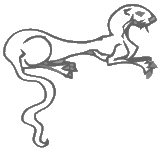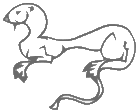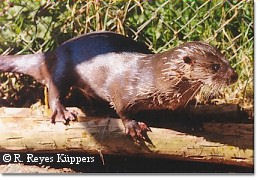 |
 |
 |
 |
 |
 |
 |
 |



Southern River Otter
Size:
From nose to tail the Southern River Otter is 100 to 116
cm long. The tail alone is 35 to 46 cm long.
Ecology Habitat: This otter lives in lakes, rivers, lagoons, and other areas with calm water, preferentially inhabiting sites in densely forested areas. These otters can be found in marine environments providing they are near a source of fresh water. Range/Distribution: The Southern River Otter inhabits southern Chile and western Argentina, and parts of Peru.
Conservation Status: Endangered
Behavior Life Cycle: Little is known about the life cycle of this species. It is assumed to be similar to those of related species. What is known is that they have a very short life span. Few live to maturity, and only 1% live 10 years of age. Social: Southern River Otters are generally solitary, only coming together to mate. The female raises the pups alone, and there are no social groups beyond this. Individual: This otter is largely nocturnal. They have territories like other otters, but the size of these territories is unknown. It appears that they are not particularly defensive of them.
Chilean river otter Spanish: Huillin, Lobito patagonico, Nutria de Chile Subspecies:
|
OtterQuest (c) 1999-current. Contact OtterQuest.
A few images on this web site have been borrowed from other sources, I credit them in the Links/Resource Page. Some may not yet be credited, if you know the source of an uncrdited photograph, please e-mail me with the information. Thank you. Dana


 Identification
Identification


